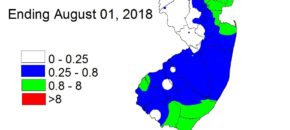Click to View | Download Report 8-7-18 Potato Disease Forecasting Report We will be tracking DSVs for Late blight development and calculating P-days for initiating the first early blight fungicide application. The first late blight fungicide application is recommended once 18 DSVs accumulate from green row. Green row typically occurs around the first week in May […]
Continue reading...Potato | Tomato Disease Forecast 8-4-18
Click to View | Download Report 8-4-18 Potato Disease Forecasting Report We will be tracking DSVs for Late blight development and calculating P-days for initiating the first early blight fungicide application. The first late blight fungicide application is recommended once 18 DSVs accumulate from green row. Green row typically occurs around the first week in May […]
Continue reading...Vegetable Disease Update – 8/3/18
Cucurbit downy mildew has been confirmed on cucumber, butternut squash, and pumpkin in NJ this growing season. Recent weather has been ideal for its development. All cucurbit growers should scout their fields on a regular basis and consider adding a downy mildew specific fungicide to their weekly maintenance sprays. CDM has been reported in cantaloupe in MD this past […]
Continue reading...Summer Farm Market Tour Aug 29
In association with Rutgers Cooperative Extension, the NJFDMA (that’s the New Jersey Farmers’ Direct Marketing Association) would like to invite farm marketers to join them for their late summer farm market tour on August 29, 2018. Tentative schedule: 1:00pm: Pick up at the Rutgers Cooperative Extension of Atlantic County building in Mays Landing 2:15pm: Pick […]
Continue reading...Fruit IPM For 08/02/18

Peach: Oriental Fruit Moth (OFM): Third flight adults are present and trap counts are low on most farms, except in isolated areas in northern counties. The timing for 3rd generation treatments is done in southern counties, but ongoing in northern counties. Please see table below for timing:
Continue reading...IPM Update 08/01/18

Sweet Corn European corn borer (ECB) moth catches in black light traps have dropped to very low levels again. The second flight is likely to be very erratic, with specific locations getting low numbers of moths while other regional traps catch none. There will be no map in this edition. Second generation feeding is often obscured by […]
Continue reading...